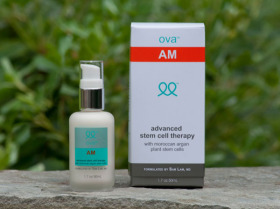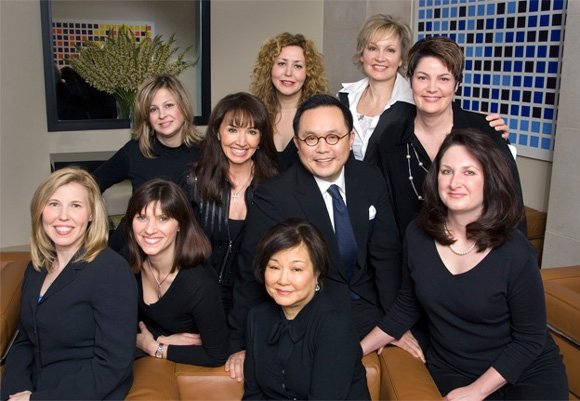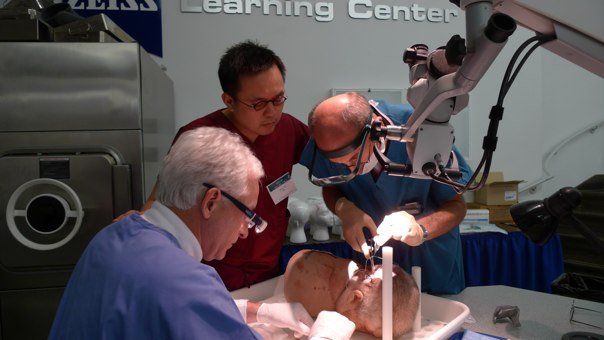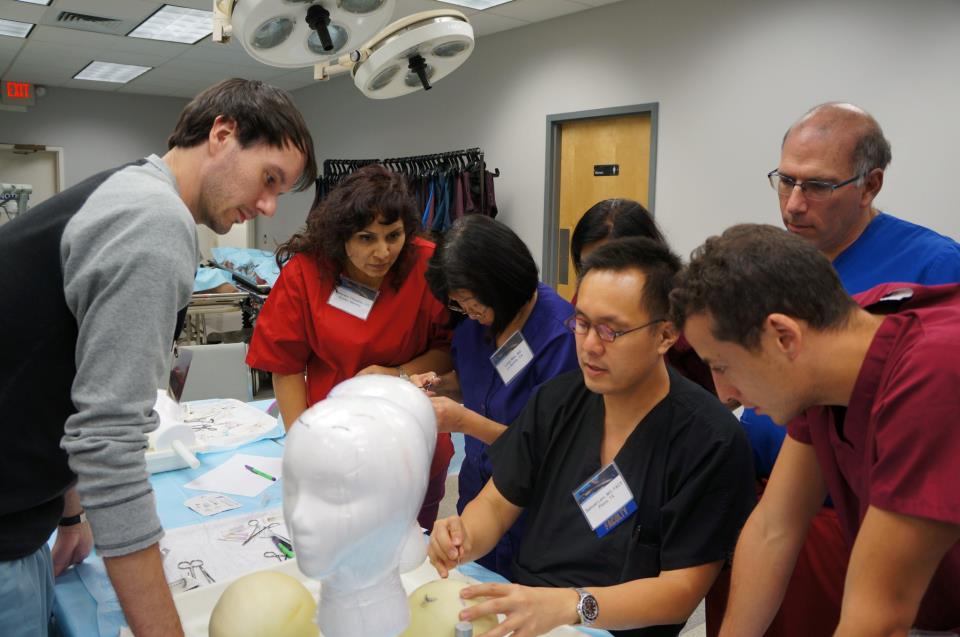Samuel Lam, MD, FACS: Plastic Surgeon, Artist & Entrepreneur In Dallas, Texas
Double board certified in facial plastic surgery and hair restoration, Dr. Samuel Lam keeps himself busy with his Ova skin care line and lecturing worldwide.

Dr. Sam Lam is a triple board-certified facial plastic surgeon who is world renowned for his pioneering work in facial rejuvenation and hair restoration. He is the owner of the 27,000 sq.ft. Willow Bend Wellness Center. He has authored five major medical textbooks, Comprehensive Facial Rejuvenation, Cosmetic Surgery of the Asian Face, Complementary Fat Grafting, Simplified Facial Rejuvenation, and Hair Transplant 360 along with over 150 book chapters and scientific papers. He lectures monthly nationally and internationally with well over 100 lectures to date. He is the 2002 winner of the John Orlando Roe Research Prize for his research on skin rejuvenation.
Name: Dr. Samuel M. Lam
Clinic: Lam Facial Plastic Surgery Center
Location: Dallas, TX
Website: lamfacialplastics.com, hairtx.com, ova-skin.com
That's interesting: After 2 years of research and development, Dr. Lam launched his new skin care line, OVA, that features plant-derived stem cells for skin rejuvenation, that is simple to use with only one morning product and one evening product.
He is an accomplished artist having completed all of the illustrations for three of his medical textbooks along with many drawings for his scientific articles and book chapters. He enjoys painting during his free time and has on display over 150 of his original paintings in the new wellness center. He's also a certified PADI divemaster.
Can you tell us about how you ended up as a plastic surgeon, researcher, and entrepreneur with your own skin care line?
Part of it was planned determination and part of it was what Steve Jobs calls “connecting the dots backwards”. Jobs mentioned that he loved calligraphy when he was at Reed College. He never knew that it would be so influential years later when he introduced to the world the concept of the font with the release of the first Macintosh in 1984. I was a history major in college and because of that background, I have been able to write prolifically without much difficulty and also be an engaging public speaker throughout the year. I started my residency in head and neck surgery at Columbia University and when I heard Gene Tardy, a very patrician facial plastic surgeon, speak about rhinoplasty, I realized that I could integrate my passion for art and science. I believe what motivates me every day is being able to perform my art. That creativity inspires me.
 The idea of the skin care line started 2 years ago when I realized that most products out there were bunk. Too many steps, too complicated, too many chemicals, and little performance. I was blown away with the final formulation of my product OVA when we integrated plant stem cells. I saw a difference in my skin within 2 days. I have never seen that with any other product. This skin care line involves a single step besides the cleanser and there are no eye and neck creams or hand creams. It is all in a single morning and a single night product. As a guy, I have no time for putting creams on, and this product is profoundly simple to use. When I asked my biochemist, “Do we really need 10 products in this line?” She responded, “No, all of that is just marketing.” That is why I felt comfortable that we could put 10 active ingredients into a single bottle and blow away the market with this. I was also able to express my passion for design by designing every element of this product including the box, logo, name, bottle, colors, lines, practically everything.
The idea of the skin care line started 2 years ago when I realized that most products out there were bunk. Too many steps, too complicated, too many chemicals, and little performance. I was blown away with the final formulation of my product OVA when we integrated plant stem cells. I saw a difference in my skin within 2 days. I have never seen that with any other product. This skin care line involves a single step besides the cleanser and there are no eye and neck creams or hand creams. It is all in a single morning and a single night product. As a guy, I have no time for putting creams on, and this product is profoundly simple to use. When I asked my biochemist, “Do we really need 10 products in this line?” She responded, “No, all of that is just marketing.” That is why I felt comfortable that we could put 10 active ingredients into a single bottle and blow away the market with this. I was also able to express my passion for design by designing every element of this product including the box, logo, name, bottle, colors, lines, practically everything.
Finally, the skin care line allows me to give back to our community. 5% of all profits go to support Off the Mat, an organization that is helping to eradicate sex slavery in India where underage girls are sold against their will into sex slavery, impregnated and then their children are forcibly placed into the same trade. Part of the effort is to retrain them in a legitimate, non-sex trade so that they can survive. The thing that riles me the most is human rights violations and stopping man’s inhumanity to man. That is what I am passionate about.
You're a winner of the John Orlando Roe Research Prize for research on skin rejuvenation. Can you tell us about your research background and how that's helped (or hindered) your career?
Even though I lecture throughout the year and write a lot of articles and books, I really do not perform active research today. It is just not my cup of tea. We all have to know what we love and what we don’t. The award was for best clinical research during my fellowship in facial plastic surgery. It involved evaluating whether certain non-invasive lasers would be beneficial for the skin. The biggest thing I learned is that sometimes basic science research that shows improvement in skin may not translate into real-life clinical scenarios. That was the point of the study. I am very proud of it but it is something that has little impact on my life as a surgeon today.

You're pretty involved with the 'fat transfer' procedures. Tell us where you think that fat transfer fits in your practice and where you think fat transfer procedures are going in the future?
I think fat transfer is the single most important advance in the last decade in facial rejuvenation.
I remember 2 years into my practice sitting in a lecture hall hearing my world shatter. I looked at photos and philosophy that forced me to do a hard-nosed evaluation of my practice and I realized that what I was doing was not right. Browlifts in people that did not need them and facelifts that were done too prematurely. Fat transfer if done well (and that is a big caveat) can make someone tremendously more youthful, attractive, and feminine (for women that is), all without any cutting. Unfortunately today, I think very unartistic overfilled faces is more the norm. You see this in celebrities today. We have gone from overlifted to overfilled results. I hate them. Fat grafting can truly be a wonderful artistic endeavor, and it certainly has been for me. I think my work does not look like anyone else’s, as it reflects my aesthetic sensibility. The beautiful thing is that if done well it is safe, permanent (minus ongoing aging), and natural.
You've written five major medical textbooks including Comprehensive Facial Rejuvenation and Cosmetic Surgery of the Asian Face, you're regularly publishing and speaking, and you're running your own clinic. Where have you made conscious decisions to try and focus your career and where has serendipity come in to play?
I think as I mentioned both are always in action. But I like the expression that chance favors the prepared mind. I will never take credit for all my success. It is the hard work of all my wonderful staff who are imbued with the same passion, integrity, and work ethic that I have. In short, they share the same culture I espouse. I love going to and lecturing at conferences. I think by going to so many meetings each year I not only build up a network of colleagues and friends but I learn so much new information that I think my colleagues who only go to one a year or fewer than that simply don’t get. For example, I have been using platelet rich plasma (PRP) in my hair restoration work that has simply revolutionized my practice. The consistency, speed, and quality of growth now is unmatched. I have been blown away. I learned that in Anchorage, Alaska last year at the International Society of Hair Restoration Surgery’s Annual Meeting. That is only one of so many advances that I have incorporated into my practice in the past year alone.

Running a 27,000sq ft wellness center must come with some notable experiences. What have you learned about about staffing and operations that other physicians could benefit from?
I think the best thing I have done is join the chapter of the Entrepreneur’s Organization in Dallas 6 years ago. As a physician, I do not have real business experience and way too many years in school, I really benefit from the education, experience, and collegiality of my peers in EO and have found it to be like a mini-MBA for me. When I moderated my forum group 2 years ago, I was able to really learn how to lead leaders, something very hard to do. Also, running now 5 businesses (my plastic surgery practice, my salon, my spa, my skin care line, and my building) has taught me a lot about business that I think I would never have gotten just running my own practice. I also learned a lot from my mentor Ed Williams, who was my fellowship director, and who really inspired me as a business leader. Fortunately, I was able to get him excited to get into EO, which he says is one of the best things he has done.
What IPL and laser technologies are you using and why did you choose these particular platforms?
I use Alma lasers and the Soprano XL for laser hair removal. I rely on plasma skin resurfacing for the skin at a deeper level. I was impressed with these technologies for two reasons: safety and efficacy. Regarding safety, I have anecdotally heard too many problems with fat loss and other issues with other types of very strong IPLs. I have never heard of or encountered that with these technologies. I also like the fact that they provide wonderful skin rejuvenation without the egregious downtime and risk of loss of pigment associated with traditional CO2 resurfacing. In short, I am very happy with the technologies that I am using today.

Where do you think that 'plastic surgery' will be replaced by technology in the future?
Obviously, the trend today is toward less and less invasive procedures. People simply do not want big surgeries. However, sometimes technology may not work as well as we would think. I performed a suture based lifting procedure for the neck in the past that has not lived up to my expectations. Going back to perform a facelift albeit with small incisions is still the way to go in my practice. I like the expression that one should not be the first person on the block to do something or be the last. One of the biggest technological advances is the use of disposable microcannulas to perform injections in the face with fillers. The ability to contour complex areas is unlike anything ever that I have encountered. I am able to perform a “fat transfer” type look without doing fat. Of course, these are with temporary fillers and therefore it can be quite expensive (even more expensive than fat grafting) if someone needs a lot of fillers. Every time I go to a major conference I pick up an amazing pearl that completely changes my practice in a good way. I think technology will continue to evolve and be powerful adjuncts to plastic surgery. I don’t think it will replace it anytime soon. But who knows?
What advice would you give to other plastic surgeons about the new cosmetic technologies?
I think what I stated above is a good maxim: don’t be the first or last person on the block performing a procedure. We all remember the Contour threadlift that really did zero good for patients. The hurt that can cause a young surgeon without an established reputation could end a career. It is so important to be careful and conservative especially for someone just starting out in this field. It is important also not to listen to the vendor who will show you unbelievable before and after images but they are usually an exaggeration. It is much better to ask an established colleague who is not financially vested in the company, i.e., someone you can trust.

What's the best advice you ever received as a physician?
“Don’t be a control freak”.
I was told this in my first week of my fellowship with Dr. Williams. Of course, I was crestfallen when I was slammed like this by my mentor but he was completely right. He taught me an amazing ability to lead and that is why I think I have great, loyal staff; an amazing culture; and a thriving business that has grown every year despite any economic downturns.
About: Dr. Sam Lam is a triple board-certified facial plastic surgeon, a diplomate of the American Board of Facial Plastic & Reconstructive Surgery, American Board of Otolaryngology, and the American Board of Hair Restoration Surgery. He is in private clinical practice with his specialty focused on facial cosmetic surgery and hair restoration. He has authored 5 medical textbooks and over 150 scientific articles and book chapters. He lectures throughout the year both nationally and internationally on his pioneering surgical strategies and philosophy. He is best known for his work with facial fat transfer, an incisionless type of facial rejuvenation that is far more natural than previous techniques; natural hair restoration; ethnic facial cosmetic work; and reducing and fixing enlarged lips.
He is the owner of the 27,000 square foot Willow Bend Wellness Center in Plano, Texas, that he built from the ground up. He also owns the Jose Eber Salon and the Spa at Willow Bend in the building.
This interview is part of a series of interviews of physicians running medical spas, laser clinics and cosmetic surgery centers. If you'd like to be interviewed, just contact us.